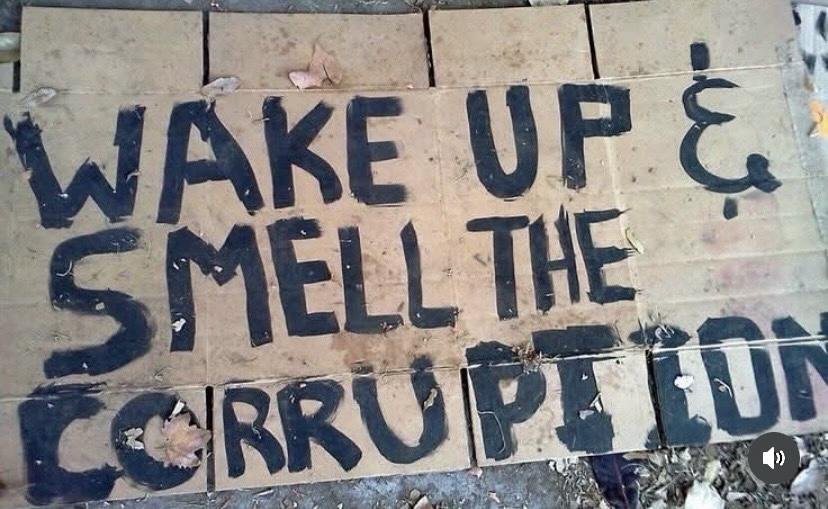“𝘞𝘢𝘬𝘦 𝘶𝘱 𝘢𝘯𝘥 𝘴𝘮𝘦𝘭𝘭 𝘵𝘩𝘦 𝘤𝘰𝘳𝘳𝘶𝘱𝘵𝘪𝘰𝘯 — 𝘪𝘵'𝘴 𝘯𝘰𝘵 𝘫𝘶𝘴𝘵 𝘪𝘯 𝘵𝘩𝘦 𝘩𝘦𝘢𝘥𝘭𝘪𝘯𝘦𝘴, 𝘪𝘵'𝘴 𝘪𝘯 𝘵𝘩𝘦 𝘴𝘺𝘴𝘵𝘦𝘮𝘴 𝘸𝘦 𝘭𝘪𝘷𝘦 𝘣𝘺. 𝘐𝘧 𝘸𝘦 𝘴𝘵𝘢𝘺 𝘴𝘪𝘭𝘦𝘯𝘵, 𝘸𝘦 𝘣𝘦𝘤𝘰𝘮𝘦 𝘱𝘢𝘳𝘵 𝘰𝘧 𝘵𝘩𝘦 𝘳𝘰𝘵. 𝘛𝘪𝘮𝘦 𝘵𝘰 𝘲𝘶𝘦𝘴𝘵𝘪𝘰𝘯, 𝘳𝘦𝘴𝘪𝘴𝘵, 𝘢𝘯𝘥 𝘥𝘦𝘮𝘢𝘯𝘥 𝘢𝘤𝘤𝘰𝘶𝘯𝘵𝘢𝘣𝘪𝘭𝘪𝘵𝘺.”
Scrawled across pieces of cardboard in thick black paint, the words aren’t just a protest sign—they are a call to consciousness. In a world where corruption has become deeply embedded in political, economic, and social institutions, this statement challenges complacency and urges individuals to recognize the decay around them. It demands awareness, action, and accountability.
Corruption is no longer hidden behind closed doors; it manifests in everyday injustices—underfunded schools, inaccessible healthcare, political manipulation, and widening inequality. When systems meant to serve the public are exploited for private gain, it is not just a political issue; it becomes a societal crisis. The sign’s raw and unpolished presentation symbolizes the grassroots frustration felt by ordinary people who are tired of being silenced or ignored.
This image serves as a wake-up call. It confronts us with the uncomfortable truth that silence and passivity enable corruption to flourish. If we truly desire change, we must first open our eyes, acknowledge the reality, and take collective action to dismantle the structures that uphold injustice.
Scrawled across pieces of cardboard in thick black paint, the words aren’t just a protest sign—they are a call to consciousness. In a world where corruption has become deeply embedded in political, economic, and social institutions, this statement challenges complacency and urges individuals to recognize the decay around them. It demands awareness, action, and accountability.
Corruption is no longer hidden behind closed doors; it manifests in everyday injustices—underfunded schools, inaccessible healthcare, political manipulation, and widening inequality. When systems meant to serve the public are exploited for private gain, it is not just a political issue; it becomes a societal crisis. The sign’s raw and unpolished presentation symbolizes the grassroots frustration felt by ordinary people who are tired of being silenced or ignored.
This image serves as a wake-up call. It confronts us with the uncomfortable truth that silence and passivity enable corruption to flourish. If we truly desire change, we must first open our eyes, acknowledge the reality, and take collective action to dismantle the structures that uphold injustice.
“𝘞𝘢𝘬𝘦 𝘶𝘱 𝘢𝘯𝘥 𝘴𝘮𝘦𝘭𝘭 𝘵𝘩𝘦 𝘤𝘰𝘳𝘳𝘶𝘱𝘵𝘪𝘰𝘯 — 𝘪𝘵'𝘴 𝘯𝘰𝘵 𝘫𝘶𝘴𝘵 𝘪𝘯 𝘵𝘩𝘦 𝘩𝘦𝘢𝘥𝘭𝘪𝘯𝘦𝘴, 𝘪𝘵'𝘴 𝘪𝘯 𝘵𝘩𝘦 𝘴𝘺𝘴𝘵𝘦𝘮𝘴 𝘸𝘦 𝘭𝘪𝘷𝘦 𝘣𝘺. 𝘐𝘧 𝘸𝘦 𝘴𝘵𝘢𝘺 𝘴𝘪𝘭𝘦𝘯𝘵, 𝘸𝘦 𝘣𝘦𝘤𝘰𝘮𝘦 𝘱𝘢𝘳𝘵 𝘰𝘧 𝘵𝘩𝘦 𝘳𝘰𝘵. 𝘛𝘪𝘮𝘦 𝘵𝘰 𝘲𝘶𝘦𝘴𝘵𝘪𝘰𝘯, 𝘳𝘦𝘴𝘪𝘴𝘵, 𝘢𝘯𝘥 𝘥𝘦𝘮𝘢𝘯𝘥 𝘢𝘤𝘤𝘰𝘶𝘯𝘵𝘢𝘣𝘪𝘭𝘪𝘵𝘺.”
Scrawled across pieces of cardboard in thick black paint, the words aren’t just a protest sign—they are a call to consciousness. In a world where corruption has become deeply embedded in political, economic, and social institutions, this statement challenges complacency and urges individuals to recognize the decay around them. It demands awareness, action, and accountability.
Corruption is no longer hidden behind closed doors; it manifests in everyday injustices—underfunded schools, inaccessible healthcare, political manipulation, and widening inequality. When systems meant to serve the public are exploited for private gain, it is not just a political issue; it becomes a societal crisis. The sign’s raw and unpolished presentation symbolizes the grassroots frustration felt by ordinary people who are tired of being silenced or ignored.
This image serves as a wake-up call. It confronts us with the uncomfortable truth that silence and passivity enable corruption to flourish. If we truly desire change, we must first open our eyes, acknowledge the reality, and take collective action to dismantle the structures that uphold injustice.




